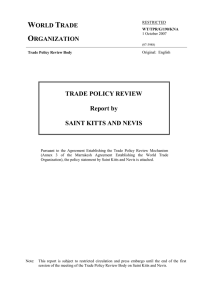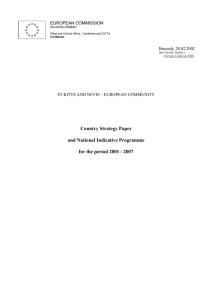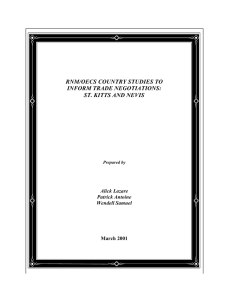Itenarary
advertisement
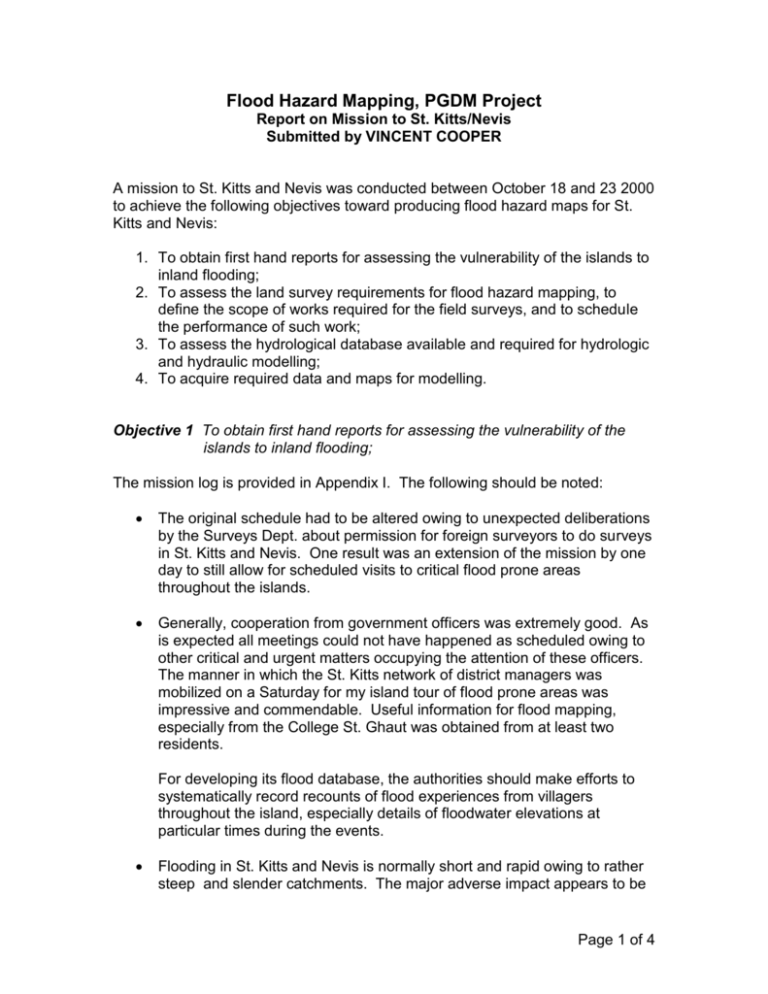
Flood Hazard Mapping, PGDM Project Report on Mission to St. Kitts/Nevis Submitted by VINCENT COOPER A mission to St. Kitts and Nevis was conducted between October 18 and 23 2000 to achieve the following objectives toward producing flood hazard maps for St. Kitts and Nevis: 1. To obtain first hand reports for assessing the vulnerability of the islands to inland flooding; 2. To assess the land survey requirements for flood hazard mapping, to define the scope of works required for the field surveys, and to schedule the performance of such work; 3. To assess the hydrological database available and required for hydrologic and hydraulic modelling; 4. To acquire required data and maps for modelling. Objective 1 To obtain first hand reports for assessing the vulnerability of the islands to inland flooding; The mission log is provided in Appendix I. The following should be noted: The original schedule had to be altered owing to unexpected deliberations by the Surveys Dept. about permission for foreign surveyors to do surveys in St. Kitts and Nevis. One result was an extension of the mission by one day to still allow for scheduled visits to critical flood prone areas throughout the islands. Generally, cooperation from government officers was extremely good. As is expected all meetings could not have happened as scheduled owing to other critical and urgent matters occupying the attention of these officers. The manner in which the St. Kitts network of district managers was mobilized on a Saturday for my island tour of flood prone areas was impressive and commendable. Useful information for flood mapping, especially from the College St. Ghaut was obtained from at least two residents. For developing its flood database, the authorities should make efforts to systematically record recounts of flood experiences from villagers throughout the island, especially details of floodwater elevations at particular times during the events. Flooding in St. Kitts and Nevis is normally short and rapid owing to rather steep and slender catchments. The major adverse impact appears to be Page 1 of 4 increased travel time owing to traffice jams (sometimes for several hours) when the ghauts flow full across the roadways. This has the potential of becoming more serious, as at least one fatality has been known of apparently many ill-advised attempts by motorists at crossing the ghauts at full flow. The flooding in Bath Ghaut watershed, within Stony Grove residential area, may be somewhat longer and widespread. The lower area of Basseterre may also have been covered with water for several hours during the big flood of 1998. The major causes of floods are: (i) inadequate designs of hydraulic structures, mainly at road crossings, where bridges and culverts are sometimes grossly undersized, inferior entrance conditions, and the use of piers within the bridge openings whose effective waterway area may be effectively much less than the design when debris becomes entrapped at the bridge entrance; (ii) improper attempts of erosion control, resulting in significant quantities of sediments being deposited at critical locations along the ghauts; (iii) inadequate maintenance of the ghauts as many require desilting; (iv) tardiness in removing vegetation entrapped at the entrances of the hydraulic structures; (v) disregard for zoning regulations, and lack of appreciation of the importance of respecting setbacks from the ghauts, even if they appear to be only dry channels; (vi) disposal of solid waste within the ghauts. Objective 2 To assess the land survey requirements for flood hazard mapping, to define the scope of works required for the field surveys, and to schedule the performance of such work See Appendix 2 for the TOR for the local and foreign surveying crews, based on assessment of the surveying requirements for completion of flood hazard mapping in St. Kitts and Nevis. The following are to be noted: Among the various options for having two crews perform the required surveys, it was realised that vital time lost could be partially retrieved by assigning the crews to different sites and having work proceed simultaneously. Had the problem with the foreign surveyors been known beforehand, the resulting increased cost and time delays may have been avoided. Based on the assessment of the foreign surveyors, no more than fifteen (15) surveying crew-days of work would be required, broken down as follows: 5 days on Bath Ghaut; 4 days on Wash Ghaut; 3 days each on College St. Ghaut and Nisbett Drainage. Page 2 of 4 Required surveying is scheduled to begin around November 01 2000, instead of on October 21 2000 as originally planned. Completion within the allotted time is dependent on timely acquisition of necessary control points by the surveying crew, from the Surveys Department. Clearance for the foreign surveyors to enter St. Kitts and Nevis and to perform works had been sought from Customs and Immigration. A letter from DK was prepared and handed to the foreign surveyor. Objective 3 To assess the hydrological database available and required for hydrologic and hydraulic modelling; Rainfall: There is a large number of raingauges scattered over the entire island that are being read by the SSMC . At the time of departure, only monthly records had been retrieved for almost every functioning gauge on St. Kitts. Daily records, however, are needed for flood studies. Mr. Robert Warner has been liaising with the SSMC and will prepare and mail my minimum request for records from at least one raingauge each measured within College St. Ghaut and Wash Ghaut. Daily records from Nevis over an extended period are not readily available. The Chief Extension Officer would attempt to provide rainfall records for significant rainfall events, such as the rain accompanying Hurricane Lenny and the big flood in 1998. Streamflow Mr. Cromwell Williams, Water Dept., confirmed the availability of streamflow records at several intake stations. This may be useful for validating results from the hydrologic model and may improve the confidence in the resulting flood hazard maps. At departure they were being prepared and will be mailed to me. Some flood elevations within College Street have been obtained from interviews with residents within the flood-stricken area. Similar information is also available from Bath Ghaut and Nisbett Drainage. The surveyors have been instructed to determine the reported elevations with respect to the national grid. Objective 4 To acquire required data and maps for modelling The table at Appendix 3 summarizes the progress in acquiring the required data and maps for the project. Mailing of several documents is to be done via courier and is being coordinated by the local coordinator of the project, Mr. David Keith. Page 3 of 4 Project Schedule Attached in Appendix 4 is the project schedule for producing the flood hazard maps. A draft copy of the maps is expected by December 08 2000. The schedule is not only for St. Kitts/Nevis, but also for the entire PGDM project, including work for Antigua and Barbuda. If requested, a separate schedule for St. Kitts and Nevis can be prepared. But, of more importance are the following: Note that the schedule is based on receiving all required maps and rainfall data by November 15 2000. If the rainfall information is not received by this time, the work will continue, but the frequency analysis would not be possible. Without the frequency analysis, at best only a mapping of the floods caused by the big flood of 1998 would be possible; that is to say, the delineation of regions as low, medium and high risk would not be possible. The soils maps are also critical to mapping as the production of design hydrographs depends on soil inputs. Failing receipt of these maps at the cut off date, the work will go ahead, but soils information will be based on the information I have gathered from conversations with various persons on St. Kitts. Were this to be done, and the soils map become available later, then modifications would be deferred until the draft maps have been submitted. Concluding Remarks Completion of the flood hazard maps hinges on the completion of the hydrologic analysis, which in turn depends especially on timely acquisition of the rainfall data. Contact with DK will be maintained and if possible, assistance in mailing the information will be provided. The accuracy of any model simulations is known only with comparison with observed data, and this might be facilitated by the available streamflow data from the Water Department. The usefulness of the data, however, would only be assessed on its receipt. Qualifying notes are to be included on the maps advising of the level of accuracy of the floodwater elevations. An obvious recommendation is for implementation of a basic data-monitoring network, and the eventual update of the maps when new data become available. Also, a systematic programme of interviewing villagers within each district may produce significant amounts of information useful to validation of flood levels accompanying various flood events. It is intended to provide as one outcome from the project, the methodology that can be followed for subsequent map updates. Page 4 of 4





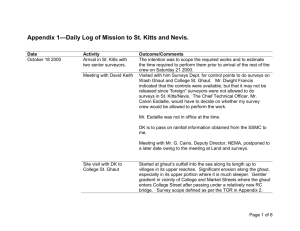
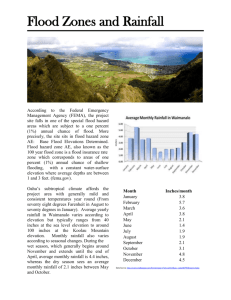

![My Flood Project [WORD 624KB]](http://s3.studylib.net/store/data/007180649_1-37937117fa0d9f223031a6f75d9a4179-300x300.png)
